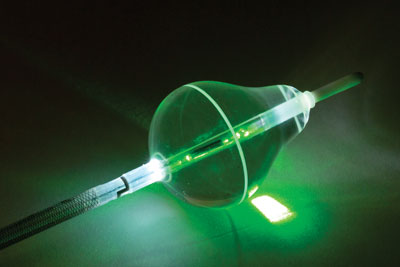Ablation system provides real-time visualization during procedure
Presenters at HRS delve into the utility, efficacy of new visually guided laser balloon catheter.
At the Heart Rhythm Society’s annual meeting in San Francisco in May, two presentations addressed the HeartLight Endoscopic Ablation System, showing the system’s efficacy for the treatment of paroxysmal atrial fibrillation in a single procedure.
The HeartLight system (CardioFocus) features a compliant balloon catheter containing a 2-Fr endoscope that allows physicians the ability to see inside the heart, as well as a 980 nm diode laser for ablation and a 30· adjustable aiming arc. According to a press release, the system allows those performing the procedure to visually direct the application of the laser to achieve durable pulmonary vein isolation. The device, currently investigational in the US, received CE mark approval in 2009 for the treatment of AF.
|
|
In the first presentation at HRS, Srinivas R. Dukkipati, MD, an assistant professor at Mount Sinai School of Medicine, New York, reported that among the 56 patients with paroxysmal AF, 98.1% of the pulmonary veins were isolated with the visually guided laser balloon catheter. At 3 months, every patient, regardless of symptoms, was brought back to see if their pulmonary veins were isolated, and Dukkipati and colleagues observed that durable isolation was present in 85.7% of pulmonary veins.
“Now, for radiofrequency ablation, taking all-comers, the rate of durable pulmonary vein isolation is between 38% and 57%,” Dukkipati said in an interview, adding, “only about a quarter of all-comers who undergo repeat procedures with radiofrequency ablation had all of their veins isolated compared with 61.5% in our study.”
Additionally, after the 3-month blanking period and 12 months of follow-up, 71.4% of patients were free of AF and off drug therapy. There were no reported cases of stroke/transient ischemic attack or death and only one case each of cardiac tamponade and phrenic nerve injury.
|
Photo courtesy of: CardioFocus |
For the second presentation, Vivek Y. Reddy, MD, a senior faculty member at Mount Sinai School of Medicine, presented data on 200 patients with recurrent, symptomatic paroxysmal AF who had undergone treatment with the HeartLight system. He and colleagues observed a similar rate of pulmonary vein isolation as found in the smaller study (98.8%), with a 6-month drug-free/freedom from AF rate of 65%.
|
|
“In this aggregate multicenter, multi-operator experience of the first 200 patients treated with the visually guided laser system, there were high rates of acute pulmonary vein isolation with a relatively low rate of complications,” Reddy said during his presentation. “This favorable experience sets the stage for truly comparative studies.”
One such comparative trial, according to Dukkipati, will be a pivotal, randomized trial that is slated to start this month. “Basically, it is going to compare the standard of care, which is a point-by-point ablation catheter (ThermoCool, Biosense Webster) that is approved for AF ablation, with the laser balloon,” he said. “This is going to show us how well the laser balloon compares to standard-of-care therapy, and we’ll be able to see how reproducible our early results are in the larger scale.” – by Brian Ellis
Disclosures: Dr. Dukkipati reports no relevant financial disclosures. Dr. Reddy reports receiving research grants from CardioFocus.



